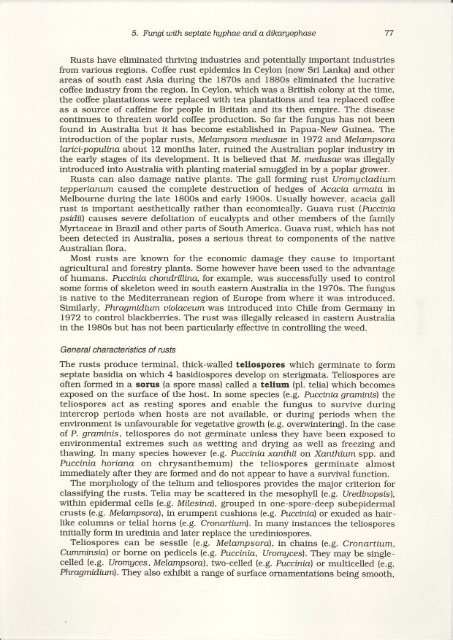Fungi with septate hyphae and a dikaryophase
Fungi with septate hyphae and a dikaryophase
Fungi with septate hyphae and a dikaryophase
You also want an ePaper? Increase the reach of your titles
YUMPU automatically turns print PDFs into web optimized ePapers that Google loves.
5. F\tngi uith <strong>septate</strong> hgphae <strong>and</strong> a <strong>dikaryophase</strong><br />
Rusts have eliminated thriving industries <strong>and</strong> potentially important industries<br />
from various regions. Coffee rust epidemics in Ceylon {now Sri Lanka) <strong>and</strong> other<br />
areas of south east Asia during the 1870s <strong>and</strong> 188Os eliminated the lucrative<br />
coffee industry from the region. In Ceylon, which was a British colony at the time,<br />
the coffee plantations were replaced <strong>with</strong> tea plantations <strong>and</strong> tea replaced coffee<br />
as a source of caffeine for people in Britain <strong>and</strong> its then empire. The disease<br />
continues to threaten world coffee production. So far the fungus has not been<br />
found in Australia but it has become established in Papua-New Guinea. The<br />
introduction of the poplar rusts, MeLampsora medusae rn 1972 <strong>and</strong> Metampsora<br />
Larict-populina about 12 months later, ruined the Australian poplar industry in<br />
the early stages of its development. It is believed that M. medusae was illegally<br />
introduced into Australia <strong>with</strong> planting material smuggled in by a poplar grower.<br />
Rusts can also damage native plants. The gall forming rust UromgcLadium<br />
tepperianum caused the complete destruction of hedges of Acacia armata nr<br />
Melbourne during the late l8OOs <strong>and</strong> early 19OOs. Usually however, acacia gall<br />
rust is important aesthetically rather than economically. Guava rust (Prrccinia<br />
psuCii) causes severe defoliation of eucalypts <strong>and</strong> other members of the family<br />
Myrtaceae imBrazlJ <strong>and</strong> other parts of South America. Guava rust, which has not<br />
been detected in Australia, poses a serious threat to components of the native<br />
Australian flora.<br />
Most rusts are known for the economic damage they cause to important<br />
agricultural <strong>and</strong> forestry plants. Some however have been used to the advantage<br />
of humans. Puccinirr chondrtLtino-, for example, was successfully used to control<br />
some forms of skeleton weed in south eastern Australia in the 1970s. The fungus<br />
is native to the Mediterranean region of Europe from where it was introduced.<br />
Similarly, Phragmidium uiolaceum was introduced into Chile from Germany in<br />
L972 to control blackberries. The rust was illegally released in eastern Australia<br />
in the 198Os but has not been particularly effective in controlling the weed.<br />
General characteristics of rusts<br />
The rusts produce terminal, thick-walled teliospores which germinate to form<br />
<strong>septate</strong> basidia on which 4 basidiospores develop on sterigmata. Teliospores are<br />
often formed in a sorus (a spore mass) called a telium (pl. telia) which becomes<br />
exposed on the surface of the host. In some species (e.9. Puccinia graminis) the<br />
teliospores act as resting spores <strong>and</strong> enable the fungus to survive during<br />
intercrop periods when hosts are not available, or during periods when the<br />
environment is unfavourable for vegetative growth (e.g. overwint.fug). In the case<br />
of P. gramrnis, teliospores do not germinate unless they have been exposed to<br />
environmental extremes such as wetting <strong>and</strong> drying as well as freezing <strong>and</strong><br />
thawing. In many species however (e.g. Puccinia xanthii on Xanthium spp. <strong>and</strong><br />
Puccinia horiana on chrysanthemum) the teliospores germinate almost<br />
immediately after they are formed <strong>and</strong> do not appear to have a survival function.<br />
The morphologr of the telium <strong>and</strong> teliospores provides the major criterion for<br />
classifring the rusts. Telia may be scattered in the mesophyll (e.g. uredinopsis),<br />
<strong>with</strong>in epidermal cells (e.g. Milesina), grouped in one-spore-deep subepidermal<br />
crusts {e.9. MeLampsorc), in erumpent cushions (e.g. Prrccinia) or exuded as hairlike<br />
columns or telial horns (e.g. Cronartium).In many instances the teliospores<br />
initially form in uredinia <strong>and</strong> later replace the urediniospores.<br />
Teliospores can be sessile (e.g. MeLampsora), in chains (e.g. cronartium,<br />
Cumminsin) or borne on pedicels (e.g. Puccinia, [Jromgces). They may be singlecelled<br />
(e.9. Uromgces, Melampsora), two-celled (e.g. Puccinia) or multicelled (e.g.<br />
Phragmidium). They also exhibit a range of surface ornamentations being smooth,<br />
77






![[Compatibility Mode].pdf](https://img.yumpu.com/27318716/1/190x135/compatibility-modepdf.jpg?quality=85)










